Nima Tsering: A violin that is "pierced" into the heart
In many places in Tibet, it can be called "every family has a 'Zha Nian'". Although not everyone at home can play and sing, people are willing to hang it at home for daily celebrations and gatherings, and it also has the connotation of gathering blessings.
There is a workshop for making "Zha Nian" on Gongpotang Road, Chengguan District, Lhasa City. The owner of the workshop, Nima Tsering, is an old artist with more than 20 years of experience in making pianos. Touching the Zha Nian made by Nima Tsering is like stroking the skin of a baby. It is so moist and shiny. It must be the purest heart with the most stable hands. In more than 20 years, the accumulated polishing and ingenuity are repeated. To be able to do this to the extreme.
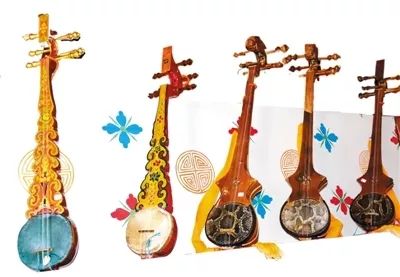
Various styles of "Zha Nian" in Tibet.
A violin "pierced" into the heart
Nima Tsering was born in a village in Bianjiaolin Township, Linzhou County. When he was over 500 years old, he wore a small braid, exuding the unique temperament of an artist.
At the age of 10, Nima Tsering was selected to be an apprentice of the propaganda team in the production team. During the slack season, he would go to the propaganda team to learn singing, dancing and other performances. At the age of 18, Nima Tsering became an official propaganda team member at Pengbo Farm, where he first came into contact with "Zha Nian".
"At that time, 'Za Nian' was very precious, and in my eyes it was more like a treasure. There were very few people who could play 'Za Nian' in Linzhou County. Zha Nian' is not easy, the teacher will not let outsiders touch easily." Nima Tsering recalled.
Whether it is a passionate revolutionary song or a melodious Tibetan folk song, under the rhythm of the propaganda team's teacher's finger up and down, the sound of "Za Nian" is so intoxicating, Nima Tsering is like a fascinated I like "Zha Nian". When the teacher was out, Nima Tsering quietly picked up "Zha Nian", hid in the corner of the room, held the qin to his chest, imitated the teacher's appearance, plucked his fingers on the strings, Carefully identify the sound from each string.
"With my own love, I quickly learned how to play 'Zha Nian'." During the time of the publicity team, Nima Tsering listened to the sound of Zha Nian from the tape on the tape recorder, while playing with the teacher learning to play the piano.
At the age of 23, Nima Tsering resigned from the propaganda team and became a carpenter with his father. He had been fascinated by his eyes and ears since he was a child, and with his interests, under the careful guidance of his father, within a few years, Nima Tsering learned to make door frames, eaves, and furniture, and began to work around.
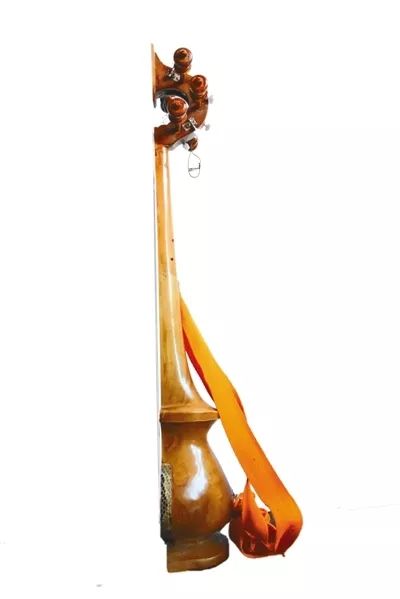
An aquarium-shaped "Za Nian" made by Nima Tsering.
One year, Nima Tsering went to Nagqu to help people build houses. A friend heard that he could play "Zha Nian" and strongly invited him to be a teacher to teach villagers how to play. Nima Tsering finished his carpentry work and agreed to a friend's invitation to stay in Nagqu for 8 months. The experience of being a teacher for the first time made Nima Tsering full of pride.
One day in 1981, Nima Tsering was wandering the streets of Lhasa. When he came to Beijing Middle Road, he saw a piano shop and stopped. A "Za Nian" with a delicate sheepskin surface hangs high in the center of the piano row, and it makes a pure and pleasant sound with a single touch. Since then, this piano has been "Zha Nian" into the heart of Nima Tsering.
"The boss asked 2,500 yuan, which can be said to be very expensive. At that time, a bowl of Tibetan noodles was only sold for 6 cents." Nima Tsering felt his empty pocket and secretly determined to make such an exquisite "Zha Nian" ".
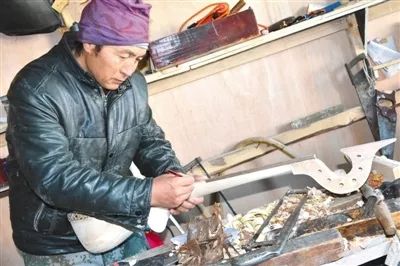
Nima Tsering handmade "Za Nian".
Running around to learn craftsmanship
In the same year, Nima Tsering came to Nyingchi City, and a friend invited him to perform "Zha Nian" in Langma Hall. Nima Tsering readily agreed, but what if there was no "Zha Nian"?
You are a carpenter, why not make one yourself? As he said, Nima Tsering made the first "Zha Nian" in his life. More than 20 years later, this "Zha Nian" is still in Nima Tsering's studio. The vermilion lacquer has become stained with time, the workmanship is not so delicate, and the appearance looks uneven, but this is still the most precious memory of Nima Tsering.
How to make a "Zha Nian" that "Zha Nian" in his heart, Nima Tsering decided to visit the master violin makers from all over Tibet to learn the methods of making "Zha Nian" in different places.
After more than 10 years of study and research, Nima Tsering has mastered the use of walnut, birch, poplar, and camphor wood for the piano body, snake skin, fish skin, and goat skin for the piano surface, Guzheng No. 8 line, Fishing line, badminton string and other string making skills can make nine kinds of "Zha Nian" in different regions, including Ali "Zha Nian", Tingri "Zha Nian", Lhasa "Zha Nian", and Mangkang "Zha Nian". In terms of appearance, the main push is the peach-shaped "Zha Nian" and the bottle-shaped "Zha Nian".
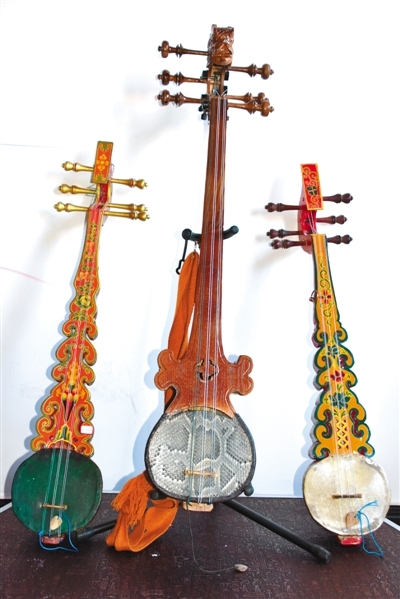
The peach-shaped "Zha Nian" (middle) represents good luck and well-being and the Lhasa-style "Zha Nian".
"First of all, the most important production process is carried out, hollowing out the whole wood to make a resonance box; making a hollow stem with a small resonance box, and matching it with a panel called 'kahu'; The headstock in the shape of a horse head, a bird head, or a dragon head, and grafted on the top of the stem; a semicircular, backward-curved, 'Za Nian' peg attached to the headstock with a string groove in the middle ; Use strings of various materials including guzheng line, fishing line, badminton line, etc. For the beauty of the body, the 'Za Nian' after the initial production needs to be carefully carved on it." Nima Tsering said. . The production process of a piano may seem simple, but it is actually complicated. It takes more than a year from the processing of the material to the finished product for a peach wood "Zha Nian".
Nima Tsering relies on his mastery of "Zha Nian" music theory and skilled manual skills. After many attempts, in 2010, he used a delicate movable wooden partition to divide the strings by moving up and down the strings. In the high and low range, it has successfully solved the problem that a "Zha Nian" cannot have both high and low frequencies at the same time.

Nyima Tsering's son Tsewang is on the strings.
Father and son carry forward national culture together
Due to the long history of "Zha Nian" and its outstanding influence in Tibetan culture, the production technique of "Zha Nian" was selected into the fourth batch of national intangible cultural heritage projects. Nima Tsering was also selected as the inheritor of Lhasa city-level intangible culture.
Although his skills are very mature, Nima Tsering also has a lot of concerns: "Za Nian" production skills are difficult, the process is complicated, and the production is more difficult. Nowadays, many young people are reluctant to learn, and many ethnic musical instrument manufacturers have begun to use them. Modern machinery makes "Za Nian". Nowadays, fewer and fewer craftsmen are proficient in this technique. He feels more and more that his job is not only to make a pile of wood into "Za Nian", but also has the responsibility to make this Tibetan folk representative. The traditional craftsmanship of sex musical instruments has been passed down.
Nima Tsering's son, Ciwang, used to work outside the home. In his spare time, he did not forget to pick up a handful of "Zha Nian" to practice his hands and promote it to those around him. In 2016, Nima Tsering established the "Zha Nian" company. Ciwang resigned to work in the company, and followed his father wholeheartedly to learn the craft of piano making and help the company's business development.
In addition to strictly requesting his son to learn piano-making skills, Nima Tsering specially set aside a room as a classroom for teaching "Zha Nian". Anyone who is willing to learn to play and sing can come to him to learn for free.
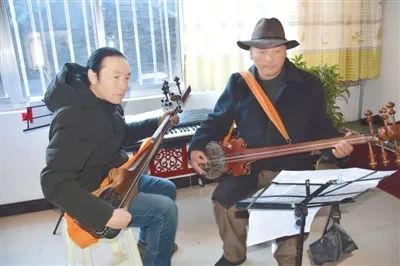
Nima Tsering (left) taught the playing method to "Zha Nian" lovers.
The piano-making workshops and classrooms are far away from the downtown area and are very quiet. "I chose to open it here because it is very close to the campus of Tibet University. It is very convenient for music teachers and students to come here to pick up the piano and change the strings." Nima Tsering told reporters that now, "Zha Nian" is very popular. Retirees are welcome, many elderly people come to study, and they also form a band. Everyone often gets together to learn skills and enjoy the beauty that music brings to life.
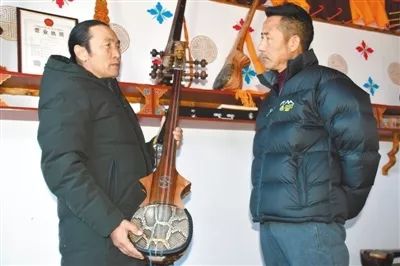
Nima Tsering (left) explained the characteristics of his hand-made "Zha Nian" to customers who came to buy "Zha Nian".
"We plan to build the largest 'Zha Nian' museum in Tibet, and prepare a more comprehensive 'Za Nian' sheet music." Today, "Za Nian" is more and more familiar to people inside and outside the region, Nima Tsering The "Zha Nian" he produced has also been sold at home and abroad. He said, "Zha Nian" in Tibetan means "sweet sound", and he hopes to spread the voice of Tibet farther through his own hands.
 渝公网安备 50010702504639号
渝公网安备 50010702504639号